Nowadays, with the development of new products and services getting larger and more complex, organizations continuously investigate and explore frameworks that will ensure initial business value, secure time and cost, and lower its delivery risk. Coupled with the fast changes in technology and market innovations, the popularity and clear superiority of the agile frameworks are becoming evident regarding its benefits and the value it can produce.
There are many methods or frameworks well-proven agile methods such as Scrum, XP, and Kanban. These agile methodologies focus on being adaptive to change and creating software iteratively. It has been widely practiced by teams of small sizes. Meanwhile, several scaling agile frameworks look to solve the problems associated with agility at scale. These framework set down the guidelines, techniques, and processes, roles and artifacts which ensure that working with hundreds of practitioners, remains coordinated and easy to manage.
The leading frameworks are Nexus, Large-Scale Scrum (LeSS), Scaled Agile Framework (SAFe) and Disciplined Agile (DA), how these frameworks differ or which one works best. In this article, we will cover the four popular scaling agile frameworks.
Before the scaling agile methods are introduced, we better review what is the level of maturity of the agile team that should have to minimize the risks for the adoption of a scaled agile approach on an enterprise scale. According to The creator of LeSS Craig Larman, the prerequisite for adopting a scaling agile method for multiple agile teams is that:
Only if each of the agile teams has the above characteristics of agility, the organization can be more comfortably adopt scaling agile method, so that we can dealing with the potential problems such as cross-team dependencies, or scheduling of release coordination for deliverables.
Ken Schwaber and Scrum.org developed Nexus, and it is just simply a framework that implements scrum at scale across multiple teams to deliver a single integrated product. Teams work in a common development environment and are focused on producing a combined increment every sprint with minimal dependencies.
It can be applied to 3-9 scrum teams. Each team consists of 3 to 9 developers. Therefore, it is not recommended to be scaled to more than 9 teams and thus, not more than eighty practitioners. Nexus is a framework that you build upon Scrum but doesn’t change that foundation of Scrum. The Nexus framework adds a new role, the Nexus Integration Team, and events: a Nexus Daily Scrum, a Nexus Sprint Planning, Nexus Sprint Backlog, and Nexus Sprint Retrospective and Refinement in the Nexus framework.
Note That:
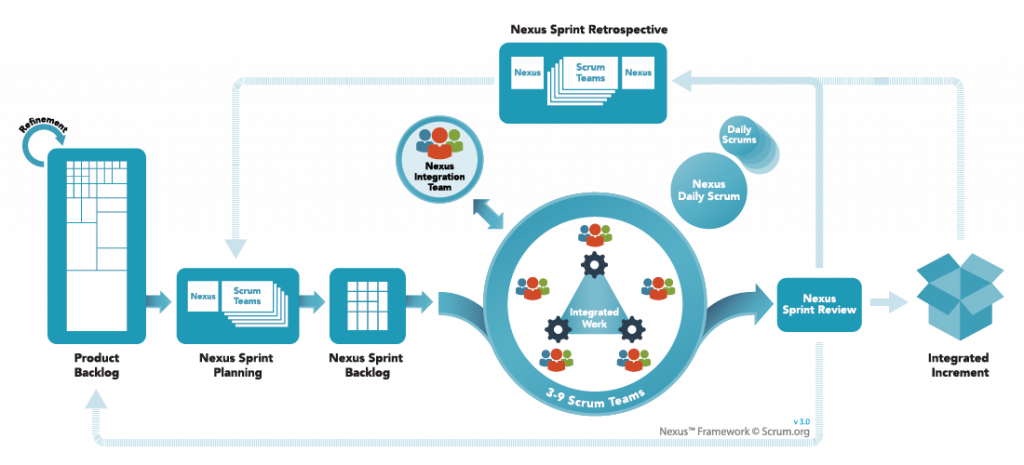
LeSS is a framework for scaling agile development to multiple teams. LeSS comes from Craig Larman and Bas Vodde and is based on their work in the financial and telecommunication industries. The framework scales up with minimal additional process compared to single-team Scrum. i.e. use as little process as possible to get multiple Scrum teams to work well. Thus, LeSS is a good starting point when you already have Scrum in place and are just beginning to scale up with more teams, one at a time.
For Example:
There is one Product Owner with one product backlog, and several teams, each with its sprint backlog. Except for the multiple teams, all these concepts are already established in Scrum, so no news here. The multiple Development Teams working on different Product Backlog Items from the same Product Backlog. Scrum Masters serve the Scrum Teams as within Scrum.
The Product Owner role in LeSS is conceptually the same as in one-team Scrum. However, at scale, the focus changes slightly toward keeping an overview and ensuring the maximum return on investment (ROI) in the product.
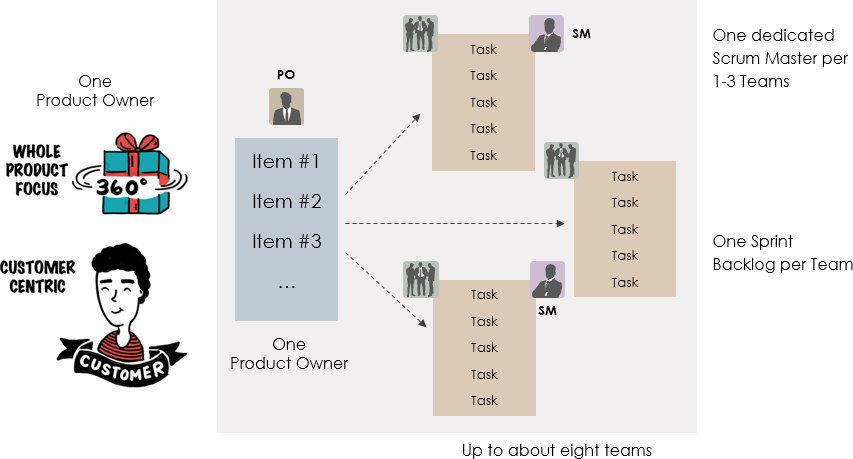
There is one product-level Sprint, not a different Sprint for each Team. Each Team starts and ends the Sprint at the same time. Each Sprint results in an integrated whole product. LeSS is pure Scrum (time-boxed iterations, sprint planning, daily stand-up, sprint review, and retrospective), with a modification. As per Scrum, Sprint Planning is split into two parts and retrospective meeting to be conducted in two levels
The first part is a joint meeting attended by representatives from all of the teams to agree “What” Product Backlog Items (PBIs) will be built in the coming Sprint. The second part of Sprint Planning is then used by each team to produce the Sprint Backlog and agree “How” the PBI’s will be built.
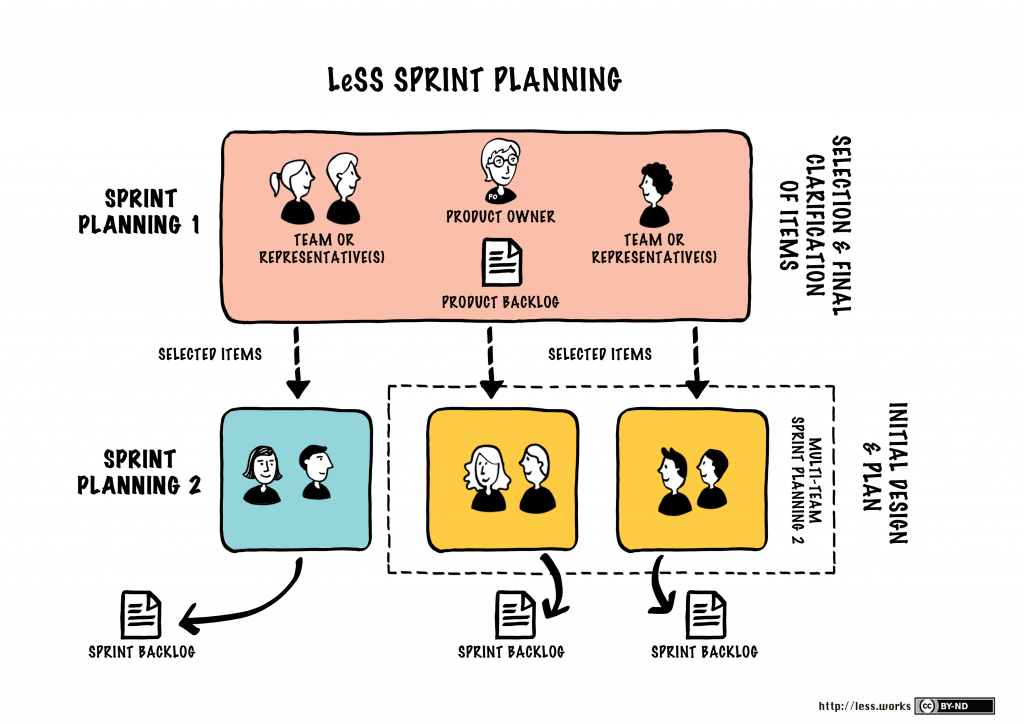
The end of the sprint also needs to be synchronized. This is accomplished by having one common Sprint Review for all the teams. The Retrospective is divided into two parts, similar to the sprint planning. First, each team holds its team Retrospective, then representatives from each team hold a joint Retrospective together that enables them to identify and address issues that cannot be solved at the individual team level.
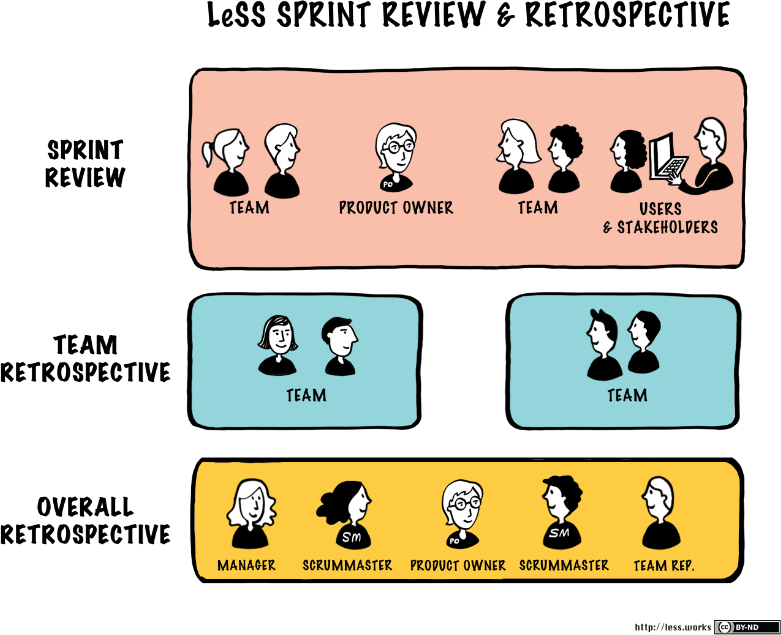
The Scaled Agile Framework (abbreviated as SAFe), Created by Dean Leffingwell, is an interactive software framework that enables you to apply Lean-Agile and Scrum practices at large enterprises. SAFe is described as an interactive knowledge base for implementing agile practices at an enterprise scale and it provides a lot of guidance and covers a broad scope including financing and enterprise architecture. SAFe is constantly being improved, and its latest version is 4.5: Full Configuration consists of four levels:
Team: the fundamentals of Scrum are used at the Team layer. Cross-functional teams that work in sprints facilitated by a Scrum Master.
Program: the gathering of multiple Agile Teams (ART’s) to deliver a collection of several Product Increments (PI’s) in about five sprints.
Large Solution: we only speak of Large Solutions when a product needs to be developed by more than 150 people. This means that additional people are added to the teams to ensure quality.
Portfolio: mainly relates to leaders within the organization. This mainly concerns employees who work with portfolio management and are responsible for the strategic plans and budgets. They are designated to determine the budgets per ART.
The cohesive integration of the Portfolio Management group within the Scaled Agile Framework brings the ability to understand, and manage, cost to market. SAFe enables Lean budgeting practices for organizations to fund products. The typical financing model of funding fragmented projects will be a thing of the past.
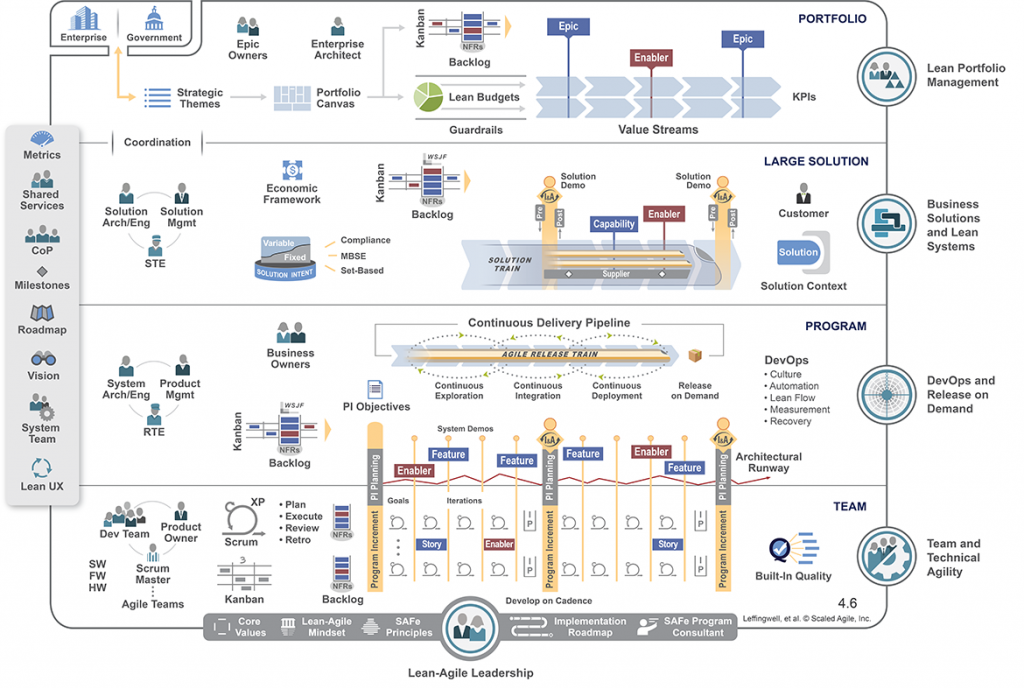
In short, the Scaled Agile Framework differentiates between Team, Large Solution, Program, and Portfolio levels. At the Team level, SAFe® is not that different from simple Scrum extended with a few XP practices. The Program level aligns the teams to form an Agile Release Train, while the Portfolio level aligns the ART with the strategic goals of higher management.
DA is subdivided into Disciplined Agile Delivery (DAD), Disciplined DevOps, Disciplined Agile IT (DAIT), and Disciplined Agile Enterprise.
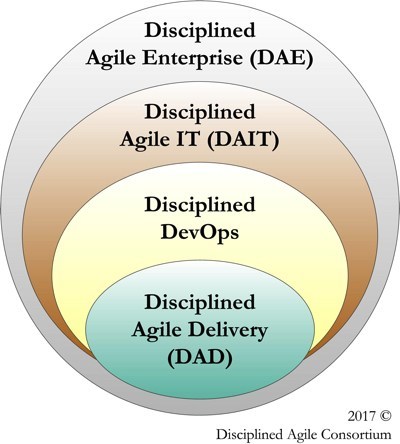
As you can see in Figure above, DAD is one aspect, and arguably the core of DA is DAD, where IT solution delivery is defined end-to-end: from initial modeling and planning, setting up the team and securing financing to continuous architecture, continuous testing, continuous development, and monitoring during the entire lifecycle.
Building on this, Disciplined DevOps and Agile IT (DAIT) focus on the coordination of a company’s IT as a whole – shaping the development cycle, operations, support, data management, and other areas to become as effective and uncomplicated as possible.
The Disciplined Agile Enterprise results from all the prior segments – a company that can anticipate market changes and adjusts its strategy accordingly. In other words, an agile company.
In general, Disciplined Agile (DA) is a hybrid toolkit that builds upon the solid foundation of other methods and software process frameworks. DAD adopts practices and strategies from existing sources and provides advice for when and how to apply them together. In one sense methods such as Scrum, Extreme Programming (XP), Kanban, and Agile Modeling (AM) provide the process bricks and DAD the mortar to fit the bricks together effectively.
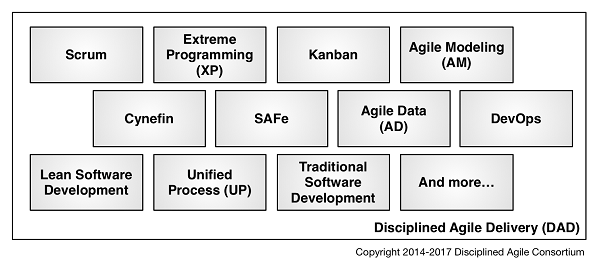
The hybrid nature of this framework pulls the best elements from several proven methodologies that allow teams to follow the agile method while also tailoring it to their unique needs. However, it is not an ideal framework for organizations new to agile, because it does not provide strict enough guidance on how to follow that philosophy. An organization newly transitioning to the agile approach, Disciplined Agile might make that learning curve too steep and costly.
Every organization is different and there isn’t a “one size fits all” approach. When deciding what large-scale agile development model works best in a particular setting, analyze the needs and constraints of your specific case. So, no matter which scaled agile approach you want to go for, there needs to be an understanding of what you need:
They seem to be similar but there are discrepancies among them that take the form of team size, training, and certification, methods and practices adopted, technical practices required and organizational type. We should choose the right one not just for now, but for the future as well.
| About Visual Paradigm |
 Visual Paradigm helps organizations stay competitive and responsive to change faster and better in today’s fast-changing environment. Our award-winning products are trusted by over 320,000 users in companies ranging from small businesses, consultants, to blue-chip organizations, universities, and government units across the globe. It enables organizations to improve business and IT agility and foster innovation through popular open standards and process frameworks. In 2019, Visual Paradigm introduced the Large-Scale Scrum Canvas for automating the way a Scrum team to create, manage and deploy software application that empowers the team to continuously improve their performance at unprecedented speed and scale. Manage the Entire Scrum Process in One Page Automate the Scrum Framework in a fun and enjoyable dashboard with eye-catching updated status. Manage Backlog, Multiple Sprints of different Scrum Roles with a single-page visually executable canvas Allow instant access, review and generate scrum artifacts and related documents to be archived in the Shared Cabinet Automate the Scrum events and related activities with self-explanatory instructions, samples, and required document templates. Visual Paradigm helps organizations stay competitive and responsive to change faster and better in today’s fast-changing environment. Our award-winning products are trusted by over 320,000 users in companies ranging from small businesses, consultants, to blue-chip organizations, universities, and government units across the globe. It enables organizations to improve business and IT agility and foster innovation through popular open standards and process frameworks. In 2019, Visual Paradigm introduced the Large-Scale Scrum Canvas for automating the way a Scrum team to create, manage and deploy software application that empowers the team to continuously improve their performance at unprecedented speed and scale. Manage the Entire Scrum Process in One Page Automate the Scrum Framework in a fun and enjoyable dashboard with eye-catching updated status. Manage Backlog, Multiple Sprints of different Scrum Roles with a single-page visually executable canvas Allow instant access, review and generate scrum artifacts and related documents to be archived in the Shared Cabinet Automate the Scrum events and related activities with self-explanatory instructions, samples, and required document templates. |